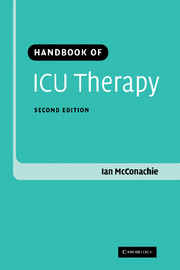Book contents
- Frontmatter
- Contents
- List of contributors
- Preface
- Part I Basic principles
- Part II Specific problems
- 17 The surgical patient in the ICU
- 18 The trauma patient
- 19 Acute coronary syndromes
- 20 Heart failure
- 21 Arrhythmias
- 22 The patient with sepsis
- 23 Acute renal failure in the critically ill
- 24 Acute lung injury and ARDS
- 25 The patient with gastrointestinal problems
- 26 The comatose patient
- 27 The critically ill asthmatic
- 28 The critically ill diabetic
- 29 The cardiac surgical patient in the ICU
- 30 Cardiac arrest
- Index
29 - The cardiac surgical patient in the ICU
Published online by Cambridge University Press: 24 August 2009
- Frontmatter
- Contents
- List of contributors
- Preface
- Part I Basic principles
- Part II Specific problems
- 17 The surgical patient in the ICU
- 18 The trauma patient
- 19 Acute coronary syndromes
- 20 Heart failure
- 21 Arrhythmias
- 22 The patient with sepsis
- 23 Acute renal failure in the critically ill
- 24 Acute lung injury and ARDS
- 25 The patient with gastrointestinal problems
- 26 The comatose patient
- 27 The critically ill asthmatic
- 28 The critically ill diabetic
- 29 The cardiac surgical patient in the ICU
- 30 Cardiac arrest
- Index
Summary
Approximately 30,000 cardiac surgical operations are performed annually in the UK. Almost all of these patients are admitted to either a general or a cardiac intensive care unit (ICU) for initial postoperative management. These patients often have clinical issues peculiar to cardiac surgery. This makes a sound understanding of the preoperative and postoperative decision making process together with an understanding of the operative techniques used, essential for intensivists involved in the care of these patients.
Preoperative
History and examination
These patients will frequently have undergone comprehensive investigation before their operation, particularly in regard to their primary cardiac pathology. Nonetheless a thorough examination and full review of the notes is needed, as these patients frequently have other pathology including carotid arterial disease, femoral arterial disease, abdominal aneurysmal disease, respiratory and renal disease which may not have been recognised or have progressed since their last examination.
Risk assessment
Since the advent of national publication of centre-specific and surgeon-specific mortality data for all cardiac operations, cardiac surgical patients are rigorously assessed in order to estimate their perioperative mortality risk. The Parsonett score has been superseded by the Euroscore and most patients have their mortality risk assessed by this score. The score estimates the patient's percentage risk of mortality and thus a patient with a Euroscore of 5 has a 5% risk of death. This score is illustrated in Table 29.1 [1, 2].
- Type
- Chapter
- Information
- Handbook of ICU Therapy , pp. 401 - 415Publisher: Cambridge University PressPrint publication year: 2006



